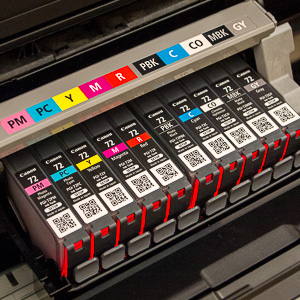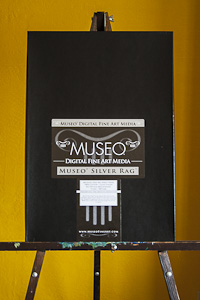Photo Corners headlinesarchivemikepasini.com
![]()
A S C R A P B O O K O F S O L U T I O N S F O R T H E P H O T O G R A P H E R
![]()
Reviews of photography products that enhance the enjoyment of taking pictures. Published frequently but irregularly.
The Big Deal With Big Printers


31 July 2013
There's no certification program to become an expert. You just wake up one day older than someone else who gets in touch to ask you a question that never occurred to you. Merely out of courtesy, you mumble something or other in general before more comfortably harping on your pet peeve for a while and then finally getting into a lather about what really bugs you. And -- presto -- you're an expert.
If we're knowledgeable about anything, its our expertise in screwing things up. We write about our screw-ups merely to deny you the pleasure of tripping over your own two feet. To music. And sometimes we have the leisure to spice our tales up with a little quiet humor to get you rolling on the floor so there's no danger of tripping with just one foot either.
But when Amadou Diallo of The Wirecutter contacted us the other day, he didn't want to talk to us about screw-ups. He wanted to talk about 13x19-inch printers. The Wirecutter is Brian Lam's best-of site that tracks down the best tech products by asking experts what they are. Diallo had confused us with an expert.
We talked about a lot of things but the discussion was more about why anybody would want a 13x19-inch printer than which printer they would be happiest with (there's little mystery on that score).
Why would anybody want one? Not your average enthusiast or budding pro, he clarified, but just your basic consumer who enjoys taking photos and has some free table space at home.
He put it this way:
At $800 is this level of printer relevant for the average user looking for great-looking prints for personal use? Would you agree with the general sentiment that for most of users it doesn't make sense to spend more on the purchase of their printer than they did on your camera?
What, in short, is the big deal with big printers?
BACKING UP A BIT
Flip the calendar back a couple of decades. You take your roll of film to the one-hour place and get two sets of 4x6 jumbo prints back. In two hours. And they're hideous. But you keep one set and give the other away.
That was then.
Flip a few years forward and you cable your camera to the USB port of your desktop computer to transfer the images over. Then you use some batch printing utility like Canon's Easy-PhotoPrint to crank out two sets of 4x6 prints on your inkjet printer with four inks.
You've already learned the hard way not to use cheap paper. You buy photo paper. Glossy photo paper. And even though the inkjet just has three colors plus black, they look better than hideous.

Larger Palette. Canon Pro-10 inkset includes Matte Black, Photo Black, Cyan, Magenta, Yellow, Photo Cyan, Photo Magenta, Chroma Optimizer, Red and Gray inks..
Time marches on and you find yourself surrounded by laptops and smartphones and other image generating devices. You invest hardly anything at all in a wireless all-in-one device when you buy a new laptop for yourself. Anyone can print to it with WiFi, even Bluetooth (because you bought a dongle that plugs into the USB port).
And even though it only uses three color inks plus black, it makes really nice glossy 4x6 prints.
But you don't make many of them any more.
Instead, you upload your birthday party pix, your wedding shots and your soccer game grabs to an online photo sharing service so everybody who was there can see them without bothering you for a print that won't look hideous but won't be quite as dazzling as the onscreen image. Sometimes you do this before you even transfer the images to your laptop.
So why would you bother buying a 13x19-inch printer for $400 (or $89 at the moment) to $800?
THE BIG PICTURE
Well, there are two reasons.

Big Prints. Two variations of our Golden Gate Bridge commemorative poster on 13x19-inch sheets.
First is the size of the print. It's an enlargement (which you could never afford when you shot film).
You aren't going to make many of these prints but a 13x19 print of your own hanging on the wall is a special joy you don't appreciate until you make one from an image that matters to you. A graduation group, a wedding shot, a still life, a landscape -- something you can look at over and over again with pleasure.
You stand back, you admire the color, the composition. Your beloved stands next to you and admires the print and maybe even you too. There's room for both.
And because it's on the wall, you live with it. Year in and year out. And every time you see it, it gives you pleasure. It really does.
Second, the media. Glossies are shiny and bright but with a big pigment printer, a new world of paper surfaces opens up. Different weights, different temperatures (warm natural sheets or cool ones with brighteners), various textures (smooth, canvas, linen, satin and more).
The glossies from that all-in-one are printed with dye inks that swell the surface of the paper encapsulating the ink. A day later the sheet is dry (as the sheet specs all warn you in small print).

Fine Art Papers. The papers themselves are works of art.
Yes, Kodak developed a pigment ink that used porous paper for an instant-dry effect, but if you run that paper through an all-in-one using dyes, it fades more quickly than anything (five years).
To print on fine art papers (which are porous) or instant-dry papers, you want a pigment printer. There are really very few papers available for dye printers any more (we use HP Premium Plus for our 4x6 dye prints), which is a shame because pigments are just not as intense as dyes (think sunsets).
Ilford would dispute that claim. Its nanoporous coating, the company claims, is designed for both pigment and dye inks. And you will certainly get a lovely looking print on them using dye inks. But, you know, porous is not swellable and without encapsulating the dyes in a gel, longevity suffers. How much we don't know, but we aren't comfortable recommending anything but a swellable gel sheet for dye inksets.
Still, the point we started to chisel is that there's a world of papers beyond the old glossy sheet. And they are each a special pleasure of their own, with rag papers giving a glow to black and white images and metallic papers a sheen to color images. And everything in between.
PIXELS
What about, you may be wondering as Diallo did, the number of pixels you have to feed that big print? Don't you have to have a $5,000 camera?
We've been making 13x19 prints since the highest resolution camera available was three megapixels. So even that PowerShot or smartphone shot is a candidate.
The thing to remember is that a large print isn't viewed from arm's distance but from several feet away. You don't see technical issues like noise in the shadows at that distance. You see the image.

Metallic Sheet. And a smartphone image.
You can capture an image that's important to you on any camera. Indeed, it's easy to forget that some of the best fine arts and photojournalistic images of the past few years have been made on "obsolete" gear. Six-megapixel Canons, say. See our review of Eye Level in Iraq for one example.
And there's no rule that says you can only print one image to a sheet. We don't mean ganging 4x6s either. We mean laying out a grid of related images. We called that a bento box when we put together a set of 12 square black-and-white images in tribute to photographer Arthur Tress last year. Great fun!
NOT FOR EVERYTHING
No, you won't use a 13x19-inch printer for everything. If you fire it up once a month, you'll be working hard. But when you're working on an image, you may find it hard to turn the printer off. It lets you look at your image in more than one way.
No wonder we make more 13x19 prints these days than 4x6 prints.
With a calibrated monitor and the right ICC profiles for the paper you're using (usually supplied by the manufacturer of the paper), there's very little frustration with results.
And that in itself is a joy.
RECOMMENDATIONS
On our Best Products Page we aren't shy about recommending two 13x19-inch printers. And we've tested quite a few over several months each.
Our favorite pigment printer is the Epson R3000 and our favorite dye printer is the Canon Pro-100. If we had to pick one of them, it would unhesitatingly be the Epson. It's that good.
CONCLUSION
The print used to be a utilitarian object, the only way to share a photograph. But there are easier ways to share images these days. Outright prolonged applause for them, too.
But any image is as easily forgotten in an online album as in your archive. A few deserve a better fate. And for those few, a 13x19 enlargement is just the ticket. A trip to the local discount frame shop can enshrine it inexpensively so all you have to do is find some wall space to enjoy it.
You may just find that, like us, you can never have enough wall space.